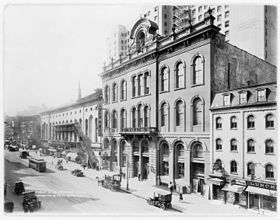Tammany Hall is the political society of the US Democratic Party in New York , which operated from the 1790s to the 1960s and controlled the nomination and patronage in Manhattan from 1854 to 1934.

History
The Tammany Hall Society, founded in 1789, was named after Tamanenda , a white-friendly leader of the Delaware Indians who allegedly signed a peace treaty with Quaker William Penn .
Tammany Hall developed its own ceremonies imitating Native American ceremonies, and initially set itself the goal of fighting for the interests of average Americans against the Federalist Party, which had gained strength. In 1800, his support helped Aaron Burr become Vice President of the United States .
After that, society strengthened its influence until it became the main political force in New York and the entire state of the same name. However, by the 1870s, it had become an instrument of the top of the Democratic Party and was distinguished by illegibility in the means and corruption of its leaders. According to minimal estimates, the time of domination of the “ Tweed gang ” in Tammany Hall from the 1850s to 1873 cost the treasury and taxpayers at least $ 75 million of that time, and the maximum - $ 200 million.
After a series of scandals and investigations in 1932, Mayor Jimmy Walker was forced to resign, and Franklin Delano Roosevelt, the newly elected president, turned against Tammany Hall. With his support, Liberal Republican Fiorello La Guardia won the important New York City Mayor’s election, after which Tammany Hall gradually began to lose its influence.
See also
- US Democratic Party
- Political machine
- Gang of tweed
- New York gangs